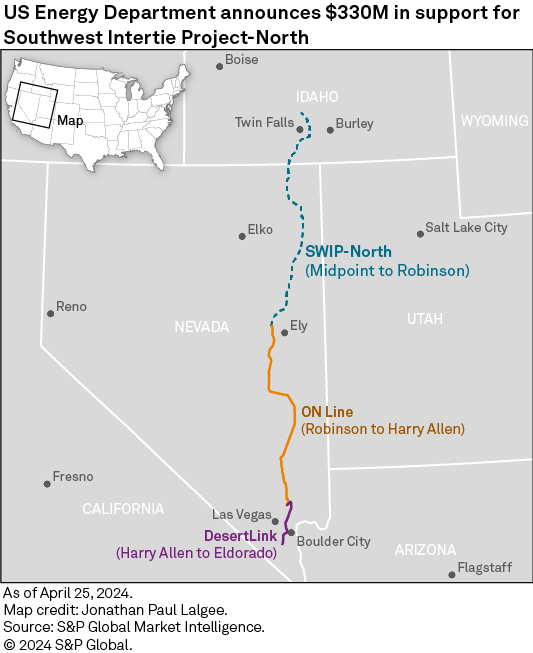The US Energy Department on April 25 announced a pair of final rules to speed the permitting process for new power lines and boost capacity on the existing transmission system, as well as $331 million in support for an intertie project extending from southern Nevada to Idaho.
One of the final rules will make the DOE the lead agency for National Environmental Policy Act reviews for new power lines rated 230 kV and above. The rule creates a new program called the Coordinated Interagency Transmission Authorization and Permits (CITAP) program, first proposed in August 2023.
Under the program, the DOE will coordinate efforts across eight other agencies to prepare a single environmental review document for transmission developers seeking federal approvals. The program also establishes a two-year timeline for the permitting process.
"The CITAP program gives transmission developers a new option for a more efficient review process, a major step to provide increased confidence for the sector to invest in new transmission lines," the DOE said in a fact sheet.
A second final rule creates a categorical exclusion — the simplest form of review under the National Environmental Policy Act — for transmission projects that use existing rights of way, such as reconductoring projects, as well as solar and energy storage projects on already disturbed lands.
Reconductoring is the process of replacing the conductive core of transmission lines with modern materials to increase carrying capacity, as defined by the Energy Department .
Upgrading existing lines with advanced conductors could spur a nearly four-fold increase in transmission capacity expansion by 2035 compared to a new-build-only approach, according to an April 8 report by GridLab, Energy Innovation and the University of California, Berkeley.
In a related move, the DOE said it plans to mobilize public and private sector leaders as part of a new Biden administration initiative to upgrade 100,000 miles of existing transmission lines over the next five years.
"The power sector can achieve this ambition primarily by deploying modern grid technologies like high-performance conductors and dynamic line ratings that enable existing transmission lines to carry more power," the DOE said.
Those types of grid-enhancing technologies, which can be deployed at a fraction of the cost and time required for traditional transmission solutions, could boost existing US grid capacity by 20 GW to 100 GW, according to a DOE report released earlier this month.
Applications closed last week for up to $2.7 billion in funding through the DOE's Grid Resilience and Innovation Partnerships program, the agency noted April 25. The program, funded by the 2021 Bipartisan Infrastructure Law, has already awarded $3.5 billion to projects that will upgrade and modernize the transmission and distribution system.
Southwest Intertie Project wins DOE support
The DOE on April 25 also announced up to $331 million in support for the 285-mile Southwest Intertie Project-North, known as SWIP North. SWIP North is the final 500-kV section of a three-segment transmission line that will extend the California ISO's reach across Nevada into Idaho.

LS Power Corp. completed the first 231-mile segment, called One Nevada, in 2014 through a joint venture with Berkshire Hathaway Energy subsidiary NV Energy Inc. The developer completed the southernmost segment, a 60-mile, 500-kV line running between the El Dorado and Harry Allen substations in Nevada, in 2020.
The DOE said it has committed to purchasing capacity from SWIP North through the Bipartisan Infrastructure Law's Transmission Facilitation Program. The program allows the DOE to assume the role of an anchor tenant to help de-risk transmission lines that may not otherwise get built.
SWIP North was approved in December 2023 as an addendum to CAISO's 2022–2023 transmission planning cycle. The project, being developed by LS Power subsidiary Great Basin Transmission LLC, depends on several critical decisions by other entities, including the California Public Utilities Commission, the Idaho Public Utilities Commission and the Federal Energy Regulatory Commission.
"SWIP North will deliver economic benefits and strengthen the electric grid in the western US, while also connecting renewable energy resources to customers that need them," said Paul Thessen, president of LS Power's LS Power Development LLC unit. "SWIP North's bidirectional capability and ability to unleash latent capacity on the ON Line make it a valuable and cost-effective transmission system improvement."


